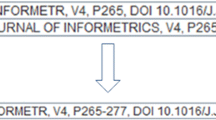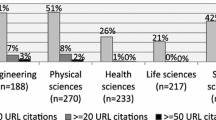Abstract
Preprint archives play an important scholarly communication role within some fields. The impact of archives and individual preprints are difficult to analyse because online repositories are not indexed by the Web of Science or Scopus. In response, this article assesses whether the new Microsoft Academic can be used for citation analysis of preprint archives, focusing on the Social Science Research Network (SSRN). Although Microsoft Academic seems to index SSRN comprehensively, it groups a small fraction of SSRN papers into an easily retrievable set that has variations in character over time, making any field normalisation or citation comparisons untrustworthy. A brief parallel analysis of arXiv suggests that similar results would occur for other online repositories. Systematic analyses of preprint archives are nevertheless possible with Microsoft Academic when complete lists of archive publications are available from other sources because of its promising coverage and citation results.







Similar content being viewed by others
Notes
References
Brown, L. D. (2003). Ranking journals using social science research network downloads. Review of Quantitative Finance and Accounting, 20(3), 291–307.
Brown, L. D., & Laksmana, I. (2004). Ranking accounting Ph.D. programs and faculties using social science research network downloads. Review of Quantitative Finance and Accounting, 22(3), 249–266.
Davis, P., & Fromerth, M. (2007). Does the arXiv lead to higher citations and reduced publisher downloads for mathematics articles? Scientometrics, 71(2), 203–215.
Delgado López-Cózar, E., & Cabezas-Clavijo, Á. (2012). Google Scholar Metrics: An unreliable tool for assessing scientific journals. El Profesional de la Información, 21(4), http://www.elprofesionaldelainformacion.com/contenidos/2012/julio/15_eng.pdf.
Delgado López-Cózar, E., Robinson-García, N., & Torres-Salinas, D. (2014). The Google Scholar experiment: How to index false papers and manipulate bibliometric indicators. Journal of the Association for Information Science and Technology, 65(3), 446–454.
Di Cesare, R., Luzi, D., Ricci, M., Ruggieri, R., della Ricerche, C. N., & della Repubblica, S. (2011). A profile of Italian Working papers in RePEc. In Proceedings of the twelfth international conference on grey literature (pp. 1–12). Amsterdam: TextRelease.
Eisenberg, T. (2006). Assessing the SSRN-based law school rankings. Indiana Law Journal, 81(1), 285–291.
Falagas, M. E., Pitsouni, E. I., Malietzis, G. A., & Pappas, G. (2008). Comparison of PubMed, Scopus, web of science, and Google scholar: Strengths and weaknesses. The FASEB Journal, 22(2), 338–342.
Gunn, W. (2013). Social signals reflect academic impact: What it means when a scholar adds a paper to Mendeley. Information Standards Quarterly, 25(2), 33–39.
Halevi, G., Moed, H., & Bar-Ilan, J. (2017). Suitability of Google Scholar as a source of scientific information and as a source of data for scientific evaluation—Review of the Literature. Journal of Informetrics, 11(3), 823–834.
Harzing, A. W. (2007). Publish or perish. http://www.harzing.com/pop.htm.
Harzing, A. W. (2016). Microsoft Academic (Search): A phoenix arisen from the ashes? Scientometrics, 108(3), 1637–1647.
Harzing, A. W., & Alakangas, S. (2017a). Microsoft Academic: Is the phoenix getting wings? Scientometrics, 110(1), 371–383.
Harzing, A. W., & Alakangas, S. (2017b). Microsoft Academic is one year old: The Phoenix is ready to leave the nest. Scientometrics, 112(3), 1887–1894.
Harzing, A. W. K., & Van der Wal, R. (2008). Google Scholar as a new source for citation analysis. Ethics in Science and Environmental Politics, 8(1), 61–73.
Haustein, S., Larivière, V., Thelwall, M., Amyot, D., & Peters, I. (2014). Tweets vs. Mendeley readers: How do these two social media metrics differ? IT-Information Technology, 56(5), 207–215.
HEFCE. (2015). The Metric Tide: Correlation analysis of REF2014 scores and metrics (Supplementary Report II to the Independent Review of the Role of Metrics in Research Assessment and Management). http://www.hefce.ac.uk/pubs/rereports/Year/2015/metrictide/Title,104463,en.html.
Hug, S. E., & Brändle, M. P. (2017). The coverage of Microsoft Academic: Analyzing the publication output of a university. Scientometrics. https://doi.org/10.1007/s11192-017-2535-3.
Hug, S. E., Ochsner, M., & Brändle, M. P. (2017). Citation analysis with Microsoft Academic. Scientometrics, 111(1), 371–378. https://doi.org/10.1007/s11192-017-2247-8.
Jaffe, A. B., Trajtenberg, M., & Henderson, R. (1993). Geographic localization of knowledge spillovers as evidenced by patent citations. The Quarterly Journal of Economics, 108(3), 577–598.
Jamali, H. R. (2017). Copyright compliance and infringement in ResearchGate full-text journal articles. Scientometrics, 112(1), 241–254.
Karki, M. M. S. (1997). Patent citation analysis: A policy analysis tool. World Patent Information, 19(4), 269–272.
Kousha, K., Thelwall, M., & Abdoli, M. (2018). Can Microsoft Academic assess the early citation impact of in-press articles? A multi-discipline exploratory analysis. Journal of Informetrics, 12(1), 287–298.
Li, X., Thelwall, M., & Kousha, K. (2015). The role of arXiv, RePEc, SSRN and PMC in formal scholarly communication. Aslib Journal of Information Management, 67(6), 614–635.
Luce, R. E. (2001). E-prints intersect the digital library: inside the Los Alamos arXiv. Issues in Science and Technology Librarianship, 29(Winter). http://webdoc.sub.gwdg.de/edoc/aw/ucsb/istl/01-winter/article3.html.
Maflahi, N., & Thelwall, M. (2018). How quickly do publications get read? The evolution of Mendeley reader counts for new articles. Journal of the Association for Information Science and Technology, 69(1), 158–167.
Mohammadi, E., Thelwall, M., & Kousha, K. (2016). Can Mendeley bookmarks reflect readership? A survey of user motivations. Journal of the Association for Information Science and Technology, 67(5), 1198–1209. https://doi.org/10.1002/asi.23477.
Orduña-Malea, E., Martín-Martín, A., & Delgado-López-Cózar, E. (2016). The next bibliometrics: ALMetrics (Author Level Metrics) and the multiple faces of author impact. El Profesional de la Información, 25(3), 485–496.
Sinha, A., Shen, Z., Song, Y., Ma, H., Eide, D., Hsu, B. J. P., et al. (2015). An overview of Microsoft Academic service (mas) and applications. In Proceedings of the 24th international conference on world wide web (pp. 243–246). New York, NY: ACM Press.
SSRN. (2017). Is my paper eligible for distribution in a SSRN eJournal? https://www.ssrn.com/en/index.cfm/ssrn-faq/#distribution_eligibility.
Sud, P., & Thelwall, M. (2014). Evaluating altmetrics. Scientometrics, 98(2), 1131–1143. https://doi.org/10.1007/s11192-013-1117-2.
Thelwall, M. (2017a). Are Mendeley reader counts high enough for research evaluations when articles are published? Aslib Journal of Information Management, 69(2), 174–183. https://doi.org/10.1108/AJIM-01-2017-0028.
Thelwall, M. (2017b). Microsoft Academic: A multidisciplinary comparison of citation counts with Scopus and Mendeley for 29 journals. Journal of Informetrics, 11(4), 1201–1212.
Thelwall, M. (2017c). Are Mendeley reader counts useful impact indicators in all fields? Scientometrics, 113(3), 1721–1731.
Thelwall, M. (2018a). Microsoft Academic automatic document searches: Accuracy for journal articles and suitability for citation analysis. Journal of Informetrics, 12(1), 1–9.
Thelwall, M. (2018b). Does Microsoft Academic find early citations? Scientometrics, 114(1), 325–334.
Thelwall, M., & Fairclough, R. (2015). Geometric journal impact factors correcting for individual highly cited articles. Journal of Informetrics, 9(2), 263–272.
Thelwall, M., Haustein, S., Larivière, V., & Sugimoto, C. (2013). Do altmetrics work? Twitter and ten other candidates. PLoS ONE, 8(5), e64841. https://doi.org/10.1371/journal.pone.0064841.
Thelwall, M., & Sud, P. (2016). Mendeley readership counts: An investigation of temporal and disciplinary differences. Journal of the Association for Information Science and Technology, 57(6), 3036–3050. https://doi.org/10.1002/asi.2355.
Thelwall, M., & Wilson, P. (2016). Mendeley readership altmetrics for medical articles: An analysis of 45 fields. Journal of the Association for Information Science and Technology, 67(8), 1962–1972. https://doi.org/10.1002/asi.23501.
van Leeuwen, T. N., & Calero Medina, C. (2012). Redefining the field of economics: Improving field normalization for the application of bibliometric techniques in the field of economics. Research Evaluation, 21(1), 61–70.
Van Noorden, R. (2014). Online collaboration: Scientists and the social network. Nature, 512(7513), 126–129.
Waltman, L., van Eck, N. J., van Leeuwen, T. N., Visser, M. S., & van Raan, A. F. (2011). Towards a new crown indicator: An empirical analysis. Scientometrics, 87(3), 467–481.
West, J. D., Jensen, M. C., Dandrea, R. J., Gordon, G. J., & Bergstrom, C. T. (2013). Author-level Eigenfactor metrics: Evaluating the influence of authors, institutions, and countries within the social science research network community. Journal of the Association for Information Science and Technology, 64(4), 787–801.
Zahedi, Z., Costas, R., & Wouters, P. (2014a). How well developed are altmetrics? A cross-disciplinary analysis of the presence of ‘alternative metrics’ in scientific publications. Scientometrics, 101(2), 1491–1513.
Zahedi, Z., Haustein, S. & Bowman, T. (2014). Exploring data quality and retrieval strategies for Mendeley reader counts. Presentation at SIGMET Metrics 2014 workshop, 5 November 2014. Available: http://www.slideshare.net/StefanieHaustein/sigmetworkshop-asist2014.
Zimmermann, C. (2013). Academic rankings with RePEc. Econometrics, 1(3), 249–280.
Zitt, M. (2012). The journal impact factor: Angel, devil, or scapegoat? A comment on JK Vanclay’s article 2011. Scientometrics, 92(2), 485–503.
Author information
Authors and Affiliations
Corresponding author
Rights and permissions
About this article
Cite this article
Thelwall, M. Can Microsoft Academic be used for citation analysis of preprint archives? The case of the Social Science Research Network. Scientometrics 115, 913–928 (2018). https://doi.org/10.1007/s11192-018-2704-z
Received:
Published:
Issue Date:
DOI: https://doi.org/10.1007/s11192-018-2704-z




